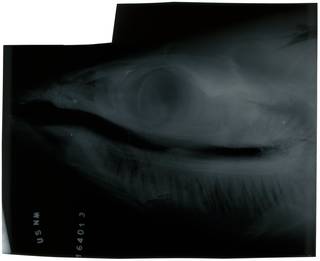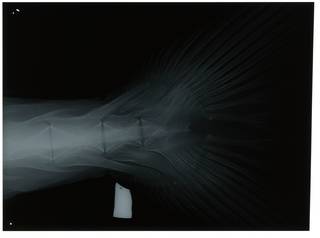WoRMS taxon details
Lepidocybium flavobrunneum (Smith, 1843)
126863 (urn:lsid:marinespecies.org:taxname:126863)
accepted
Species
Cybium flavobrunneum Smith, 1843 · unaccepted
Diplogonurus maderensis Noronha, 1926 · unaccepted
Lepidosarda retigramma Kishinouye, 1926 · unaccepted
Nesogrammus thompsoni Fowler, 1923 · unaccepted
Xenogramma carinatum Waite, 1904 · unaccepted
marine, brackish, fresh, terrestrial
Not documented
Description Occurs mostly over the continental slope, down to 200 m and more. Swims deeper at day, often migrates upward at night....
Distribution 44°N , 63°W
Description Occurs mostly over the continental slope, down to 200 m and more. Swims deeper at day, often migrates upward at night. Feeds on a wide variety of fishes (bramids, coryphaenids, scombrids, trachipterids, etc.), crustaceans and cephalopods. No special fishery, but appears as by-catch in the tuna longline fishery caught usually at depths from 100 to 300 m. Marketed mostly frozen and prepared as fish cake in Japan (Ref. 6181). Its very oily flesh may have purgative properties (Ref. 9784). [details]
Distribution 44°N , 63°W
Distribution 44°N , 63°W [details]
Froese, R. and D. Pauly. Editors. (2024). FishBase. Lepidocybium flavobrunneum (Smith, 1843). Accessed through: World Register of Marine Species at: https://www.marinespecies.org/aphia.php?p=taxdetails&id=126863 on 2024-04-23
Date
action
by
![]() The webpage text is licensed under a Creative Commons Attribution-Noncommercial 4.0 License
The webpage text is licensed under a Creative Commons Attribution-Noncommercial 4.0 License
context source (Deepsea)
Intergovernmental Oceanographic Commission (IOC) of UNESCO. The Ocean Biogeographic Information System (OBIS), available online at http://www.iobis.org/ [details]
context source (Bermuda) Smith-Vaniz, W. F.; Collette, B. B.; Luckhurst, B. E (1999). Fishes of Bermuda: History, zoogeography, annotated checklist, and identification keys (American Society of Ichthyologists and Herpetologists - Special Publication No.4) . ASIH, 424 pp. [details]
context source (PeRMS) Chirichigno, N.; Cornejo, M. (2001). Catálogo comentado de los peces marinos del Perú. <em>2ª ed. Instituto del Mar de Perú. Publicación Especial. Callao.</em> 314 p. [details]
basis of record van der Land, J.; Costello, M.J.; Zavodnik, D.; Santos, R.S.; Porteiro, F.M.; Bailly, N.; Eschmeyer, W.N.; Froese, R. (2001). Pisces, <B><I>in</I></B>: Costello, M.J. <i>et al.</i> (Ed.) (2001). <i>European register of marine species: a check-list of the marine species in Europe and a bibliography of guides to their identification. Collection Patrimoines Naturels,</i> 50: pp. 357-374 (look up in IMIS) [details]
additional source Gulf of Maine Biogeographic Information System (GMBIS) Electronic Atlas. 2002. November, 2002. [details]
additional source King, C.M.; Roberts, C.D.; Bell, B.D.; Fordyce, R.E.; Nicoll, R.S.; Worthy, T.H.; Paulin, C.D.; Hitchmough, R.A.; Keyes, I.W.; Baker, A.N.; Stewart, A.L.; Hiller, N.; McDowall, R.M.; Holdaway, R.N.; McPhee, R.P.; Schwarzhans, W.W.; Tennyson, A.J.D.; Rust, S.; Macadie, I. (2009). Phylum Chordata: lancelets, fishes, amphibians, reptiles, birds, mammals. <em>in: Gordon, D.P. (Ed.) (2009). New Zealand inventory of biodiversity: 1. Kingdom Animalia: Radiata, Lophotrochozoa, Deuterostomia.</em> pp. 431-554. [details]
additional source McEachran, J. D. (2009). Fishes (Vertebrata: Pisces) of the Gulf of Mexico, Pp. 1223–1316 in: Felder, D.L. and D.K. Camp (eds.), Gulf of Mexico–Origins, Waters, and Biota. Biodiversity. Texas A&M Press, College Station, Texas. [details]
additional source Liu, J.Y. [Ruiyu] (ed.). (2008). Checklist of marine biota of China seas. <em>China Science Press.</em> 1267 pp. (look up in IMIS) [details] Available for editors [request]
[request]
additional source Froese, R. & D. Pauly (Editors). (2023). FishBase. World Wide Web electronic publication. version (02/2023)., available online at https://www.fishbase.org [details]
ecology source Looby, A.; Erbe, C.; Bravo, S.; Cox, K.; Davies, H. L.; Di Iorio, L.; Jézéquel, Y.; Juanes, F.; Martin, C. W.; Mooney, T. A.; Radford, C.; Reynolds, L. K.; Rice, A. N.; Riera, A.; Rountree, R.; Spriel, B.; Stanley, J.; Vela, S.; Parsons, M. J. G. (2023). Global inventory of species categorized by known underwater sonifery. <em>Scientific Data.</em> 10(1). (look up in IMIS), available online at https://doi.org/10.1038/s41597-023-02745-4 [details]
context source (Bermuda) Smith-Vaniz, W. F.; Collette, B. B.; Luckhurst, B. E (1999). Fishes of Bermuda: History, zoogeography, annotated checklist, and identification keys (American Society of Ichthyologists and Herpetologists - Special Publication No.4) . ASIH, 424 pp. [details]
context source (PeRMS) Chirichigno, N.; Cornejo, M. (2001). Catálogo comentado de los peces marinos del Perú. <em>2ª ed. Instituto del Mar de Perú. Publicación Especial. Callao.</em> 314 p. [details]
basis of record van der Land, J.; Costello, M.J.; Zavodnik, D.; Santos, R.S.; Porteiro, F.M.; Bailly, N.; Eschmeyer, W.N.; Froese, R. (2001). Pisces, <B><I>in</I></B>: Costello, M.J. <i>et al.</i> (Ed.) (2001). <i>European register of marine species: a check-list of the marine species in Europe and a bibliography of guides to their identification. Collection Patrimoines Naturels,</i> 50: pp. 357-374 (look up in IMIS) [details]
additional source Gulf of Maine Biogeographic Information System (GMBIS) Electronic Atlas. 2002. November, 2002. [details]
additional source King, C.M.; Roberts, C.D.; Bell, B.D.; Fordyce, R.E.; Nicoll, R.S.; Worthy, T.H.; Paulin, C.D.; Hitchmough, R.A.; Keyes, I.W.; Baker, A.N.; Stewart, A.L.; Hiller, N.; McDowall, R.M.; Holdaway, R.N.; McPhee, R.P.; Schwarzhans, W.W.; Tennyson, A.J.D.; Rust, S.; Macadie, I. (2009). Phylum Chordata: lancelets, fishes, amphibians, reptiles, birds, mammals. <em>in: Gordon, D.P. (Ed.) (2009). New Zealand inventory of biodiversity: 1. Kingdom Animalia: Radiata, Lophotrochozoa, Deuterostomia.</em> pp. 431-554. [details]
additional source McEachran, J. D. (2009). Fishes (Vertebrata: Pisces) of the Gulf of Mexico, Pp. 1223–1316 in: Felder, D.L. and D.K. Camp (eds.), Gulf of Mexico–Origins, Waters, and Biota. Biodiversity. Texas A&M Press, College Station, Texas. [details]
additional source Liu, J.Y. [Ruiyu] (ed.). (2008). Checklist of marine biota of China seas. <em>China Science Press.</em> 1267 pp. (look up in IMIS) [details] Available for editors
additional source Froese, R. & D. Pauly (Editors). (2023). FishBase. World Wide Web electronic publication. version (02/2023)., available online at https://www.fishbase.org [details]
ecology source Looby, A.; Erbe, C.; Bravo, S.; Cox, K.; Davies, H. L.; Di Iorio, L.; Jézéquel, Y.; Juanes, F.; Martin, C. W.; Mooney, T. A.; Radford, C.; Reynolds, L. K.; Rice, A. N.; Riera, A.; Rountree, R.; Spriel, B.; Stanley, J.; Vela, S.; Parsons, M. J. G. (2023). Global inventory of species categorized by known underwater sonifery. <em>Scientific Data.</em> 10(1). (look up in IMIS), available online at https://doi.org/10.1038/s41597-023-02745-4 [details]
 Present
Present  Present in aphia/obis/gbif/idigbio
Present in aphia/obis/gbif/idigbio  Inaccurate
Inaccurate  Introduced: alien
Introduced: alien  Containing type locality
Containing type locality
From other sources
Description Occurs mostly over the continental slope, down to 200 m and more. Swims deeper at day, often migrates upward at night. Feeds on a wide variety of fishes (bramids, coryphaenids, scombrids, trachipterids, etc.), crustaceans and cephalopods. No special fishery, but appears as by-catch in the tuna longline fishery caught usually at depths from 100 to 300 m. Marketed mostly frozen and prepared as fish cake in Japan (Ref. 6181). Its very oily flesh may have purgative properties (Ref. 9784). [details]Diet Feeds on squid, crustaceans and a wide variety of fishes [details]
Distribution 44°N , 63°W [details]
Habitat Occurs mainly over the continental slope, down to 200 m and more. [details]
Habitat Known from seamounts and knolls [details]
Habitat nektonic [details]
Importance Social- Minor Commercial, fishery [details]
Remark Date Eschmeyer, pers. comm. Type species of genus. [details]
| Language | Name | |
|---|---|---|
| Dutch | botermakreel | [details] |
| English | escolar | [details] |
| French | escolier noir | [details] |
| German | Escolar-Schlangenmakrele | [details] |
| Japanese | アブラソコムツ | [details] |
| Russian | Эсколарсерая (деликатесная) макрельмасляная рыба | [details] |
| Spanish | escolar negro | [details] |
To Barcode of Life (99 barcodes)
To Biodiversity Heritage Library (1 publication) (from synonym Lepidosarda retigramma Kishinouye, 1926)
To Biodiversity Heritage Library (1 publication) (from synonym Nesogrammus thompsoni Fowler, 1923)
To Biodiversity Heritage Library (11 publications)
To Biodiversity Heritage Library (2 publications) (from synonym Diplogonurus maderensis Noronha, 1926)
To Biodiversity Heritage Library (5 publications) (from synonym Cybium flavobrunneum Smith, 1843)
To Biodiversity Heritage Library (6 publications) (from synonym Xenogramma carinatum Waite, 1904)
To Biological Information System for Marine Life (BISMaL)
To European Nucleotide Archive (ENA)
To FishBase (from synonym Cybium flavobrunneum Smith, 1843)
To FishBase (from synonym Lepidosarda retigramma Kishinouye, 1926)
To FishBase
To FishBase (from synonym Diplogonurus maderensis Noronha, 1926)
To FishBase (from synonym Xenogramma carinatum Waite, 1904)
To FishBase (from synonym Nesogrammus thompsoni Fowler, 1923)
To FishBase images (Lepidocybium flavobrunneum, Azores Is., by Cambraia Duarte, P.M.N. (c)ImagDOP)
To GenBank (370 nucleotides; 75 proteins) (from synonym Cybium flavobrunneum Smith, 1843)
To GenBank (370 nucleotides; 75 proteins)
To Global Biotic Interactions (GloBI)
To IUCN Red List (Least Concern)
To NMNH Extant Collection (Lepidocybium flavobrunneum RAD103828-001)
To PESI
To ITIS
To Biodiversity Heritage Library (1 publication) (from synonym Lepidosarda retigramma Kishinouye, 1926)
To Biodiversity Heritage Library (1 publication) (from synonym Nesogrammus thompsoni Fowler, 1923)
To Biodiversity Heritage Library (11 publications)
To Biodiversity Heritage Library (2 publications) (from synonym Diplogonurus maderensis Noronha, 1926)
To Biodiversity Heritage Library (5 publications) (from synonym Cybium flavobrunneum Smith, 1843)
To Biodiversity Heritage Library (6 publications) (from synonym Xenogramma carinatum Waite, 1904)
To Biological Information System for Marine Life (BISMaL)
To European Nucleotide Archive (ENA)
To FishBase (from synonym Cybium flavobrunneum Smith, 1843)
To FishBase (from synonym Lepidosarda retigramma Kishinouye, 1926)
To FishBase
To FishBase (from synonym Diplogonurus maderensis Noronha, 1926)
To FishBase (from synonym Xenogramma carinatum Waite, 1904)
To FishBase (from synonym Nesogrammus thompsoni Fowler, 1923)
To FishBase images (Lepidocybium flavobrunneum, Azores Is., by Cambraia Duarte, P.M.N. (c)ImagDOP)
To GenBank (370 nucleotides; 75 proteins) (from synonym Cybium flavobrunneum Smith, 1843)
To GenBank (370 nucleotides; 75 proteins)
To Global Biotic Interactions (GloBI)
To IUCN Red List (Least Concern)
To NMNH Extant Collection (Lepidocybium flavobrunneum RAD103828-001)
To PESI
To ITIS


